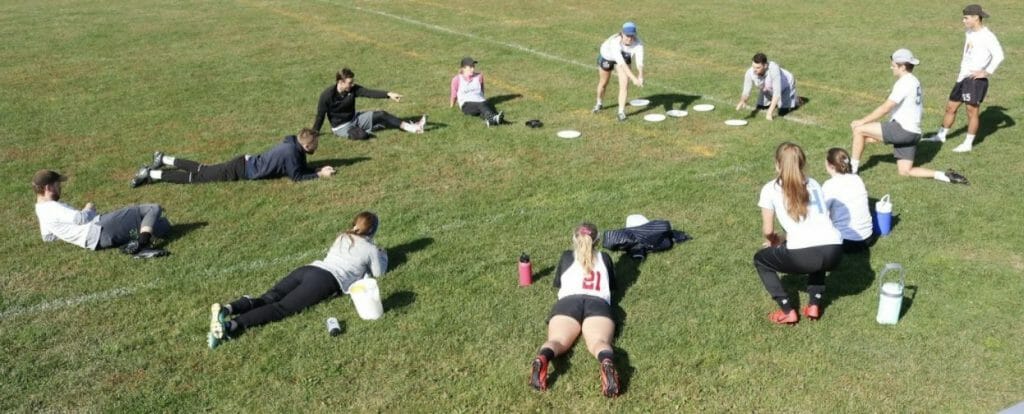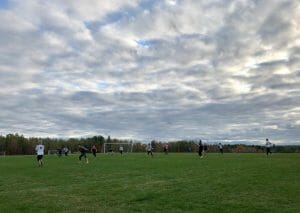With COVID cases close to zero, a 7-on-7 tournament was possible.
October 8, 2020 by Kelsey Hayden in Other, Recap with 0 comments

On October 3rd, I laced up my cleats, put on my knee brace, and jogged around a field to warm up for an ultimate game for what felt like the first time in forever. The warmup was extensive out of consideration for the seven-month break that preceded it, and yet still two days later, I can barely walk because my body is so sore. But having not felt sore from sport since March, I am so grateful for my tight calves and aching arches.
Let me give you some context before you judge the fact that I just played in a real, live 7-on-7 ultimate tournament. I live on the east coast of Canada in Halifax, Nova Scotia. While Canada as a whole has had its challenges lately with spiking COVID-19 cases across the country, Nova Scotia is part of a sheltered little paradise called the “Atlantic Bubble.”
Let me explain. When the pandemic began shutting things down in North America around mid-March, each province in Canada began its own version of lockdown. In the case of Nova Scotia, that meant everything from restaurants to stores to parks were shut down and about the only thing you were allowed to do was get groceries every 1-2 weeks and go for a walk in your neighborhood — in fact, it was illegal to drive somewhere to walk. As you likely know, the Canadian-American border was shut down in late March, and to further isolate us, the Nova Scotia border was closed to other provinces except for absolutely essential travel. And if anyone did enter the province, they had to partake in a mandatory 14-day quarantine where they could be charged or arrested if they left their home.
After several months of these strict conditions and a few instances of people being severely penalized for breaking the rules, cases in Nova Scotia, as you might expect, went way down. Our immediate neighbors in the other three Atlantic provinces — Newfoundland and Labrador, Prince Edward Island, and New Brunswick — all took similar, intense approaches, and by the end of June, there were only a handful of cases across all four provinces and no evidence of community spread.
Enter the Atlantic Bubble.
Since July 3rd, 2020, travel between the four Atlantic provinces has been permitted without the requirement to self-isolate upon entry, though travel from outside the four provinces still requires a strictly enforced 14-day quarantine period. Although there was a lot of opposition from some residents who were afraid there would be a new spike in cases, the situation on the east coast of Canada has been safe and well-managed. To put numbers to this claim — as of October 3rd, when I played ultimate, there were a total of 13 active cases among the over 2.4 million residents in Atlantic Canada. All cases were traced to travel outside the bubble, and every known case was self-isolating as required.
The public health rules vary between provinces, and throughout the past few months, restrictions have changed within the Bubble provinces since cases have remained very low. In Nova Scotia, masks are mandatory in all public indoor spaces, while gathering limits have increased in certain situations. In all of Atlantic Canada, versions of sport are allowed again. So when a tournament was advertised in Moncton, New Brunswick, just 2.5 hours from my home, I couldn’t resist. My friends and I put together a 12-person group and signed up for Mucbowl with six other teams.
The tournament specs were as follows: seven teams, one day, 60-minute games, a maximum of four games per team. Codiac Ultimate, who put together the tournament, created a “Mucbowl Plan” that was distributed to all participants and contained the COVID-19 specific procedures in place for the day. Here are the general guidelines we followed:
Teams and Rosters
- Only teams consisting of people living in the Atlantic Bubble could participate
- Every player had to complete a COVID-19 screening questionnaire prior to arriving at the fields
- Maximum roster size of 18
In-Game Play
- While playing, teams set up on opposite sidelines and maintained 2m social distancing
- Players on the field were to maintain 2m distancing with all others as best as possible, including when marking on the disc
- When the disc was in the air, the 2m guideline was not in effect so that both the offensive and defensive players could have an equal opportunity to make a play on the disc
- Once possession was made by either player or the disc hit the ground, the 2m distance must be re-established
- A player could call “distance” when 2m was not given: this was treated the same as a marking violation (play did not stop unless there were repeated violations)
General Rules
- Each team maintained a stack of sanitized discs and a “fresh” disc was used for each point
- Players regularly sanitized hands throughout games and did not share water or food
- No outside spectators were permitted, and those players watching games must maintain 2m distancing from other spectators

So what did all these new rules feel like in play? Honestly, it barely felt any different than any other recreational tournament I’ve played in. Staying further back when marking the disc felt a little strange for the first few points, but it took less than half a game for it to feel totally fine. And staying 2m away from my check downfield was just business-as-usual for a veteran (read: lazy) player like myself.
The only time things felt a little awkward was when you would catch the disc in the middle of the field and look down to see bodies everywhere. People weren’t in tight little pairings and so it sometimes seemed like the lanes were more congested — it felt like everyone was a little free, but no one was wide open. But even this became more normal throughout the day — by our last game, the championship, we had adjusted our offense and defense to account for these subtle changes and things started flowing and feeling great.
Spirit looked a little different than usual, too, since high-five lines and spirit huddles were out of the question. But as people so often argue, Spirit is not simply giving a mandatory high five or circling up to compliment each other — spirit is embedded in the game, and so even without these common niceties, it felt like a spirited, fun competition.
In fact, I would argue that these new rules enhanced spirit rather than hindered it. Everyone did their best to adhere to the guidelines and communicated effectively when necessary. People generally had more body control and self-awareness, and players didn’t seem to create nearly as many of the dangerous situations that usually occur when you play in a competitive but recreational game. Despite the rule of distancing not applying when the disc was in the air, defense and offense alike seemed to be more honest with themselves about whether they had a play on the disc and didn’t just mindlessly add themselves to a pile of humans, which is what often happened pre-COVID leading to injuries and accidents.
So that’s it: about seven months since everything effectively shut down, I played ultimate again, and it felt safe.
Stepping on that field brought forward a lot of emotions, some of which I am still identifying. But as is the case whenever you lose something good and get it back, I felt grateful. Grateful for my fellow Atlantic Canadians for working hard to adhere to all the rules these past seven months, grateful to our public health decision-makers and workers for making the right calls, and grateful that I can now spend too much time, money, and energy on ultimate again.
I don’t know how things will continue to unfold in my area. Though things feel safe right now, we must remain vigilant because if we have learned anything in the past seven months, COVID-19 thrives on complacency. What I do know is that I am lucky to be in a situation where ultimate is safely available, and I will continue to remind myself of this every time I step on the field, and especially every time I walk off the field feeling sore, tired, safe, and happy.